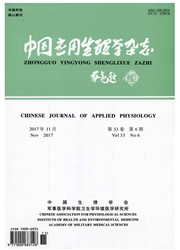

 中文摘要:
中文摘要:
目的:通过研究高脂饮食和有氧运动对胰岛素抵抗(IR)小鼠骨骼肌雷帕霉素靶蛋白/核糖体S6激酶1(mTOR/S6K1)通路的影响,试图为运动防治IR提供理论依据。方法:8周C57BL/6小鼠随机分为正常饮食组和高脂饮食组,每组各20只,高脂饮食组喂养8周后建立IR模型。随后将正常饮食组再次随机分为正常饮食安静组(NC)和正常饮食运动组(NE);高脂饮食组也随机分为高脂饮食安静组(HC)和高脂饮食运动组(HE)。各运动组进行为期6周、75%VO2max强度跑台训练,每天1次,每次60min,每周5次。实验结束后采用OGTT检测葡萄糖耐量,组织学检测胰岛形态变化,ELISA法检测血清空腹胰岛素水平,Northern blot、Western blot检测骨骼肌中mTOR和S6K1 mRNA和蛋白及其磷酸化蛋白pS6K1-Thr389的表达。结果:与NC组相比,HC组小鼠体重、空腹血清胰岛素值和胰岛β细胞团面积百分比均呈显著增加,且OGTT曲线显示糖耐量明显受损,然而6周有氧运动后以上各指标呈显著性降低,葡萄糖耐量也得到明显改善;且骨骼肌中mTOR、S6K1、pS6K1-Thr389 mRNA和蛋白表达均明显降低。结论:mTOR/S6K1信号通路与高脂饮食诱导IR的发生密切相关,有氧运动明显增加了机体组织对胰岛素的敏感性,推测有氧运动可能通过抑制mTOR/S6K1信号通路,增加IR小鼠骨骼肌的能量代谢从而改善IR。
 英文摘要:
英文摘要:
Objective:In order to provide theoretic evidence of exercise preventing insulin resistance,we studied the effects of high-fat diet and aerobic exercise on expression of mammalian target of rapamycin/ribosomol protein kinase (mTOR/S6K1) in skeletal muscle of insulin resistant mice. Methods: 8-week old,C57BL/6 mice were divided into two groups: which are normal chow and high-fat diet groups,each group has 20 animals feeding by normal chow and high fat diet respectively. 8-weeks later,mice from high fat diet group were proved to have insulin resistance symptoms and after that time point the mice were regrouped. The normal chow group was randomly divided into normal chow diet control group (NC) and normal chow exercise group (NE),and the high fat diet group was randomly divided into high fat diet control group (HC) and high fat diet exercise group (HE). All exercise groups were required to running on treadmill for 6 weeks. Mice were acclimatized to the motorized treadmill by running 60 min per day at the intensity of 75%VO2max five days per week for 6 weeks. By the end of training,we observed the changes of glucose tolerance by oral glucose tolerance test and morphology of pancreatic islet under microscope. Insulin concentration was measured by ELISA. Northern blot and Western blot were performed to detect mTOR、S6K1(and/or pS6K1-Thr389) mRNA and protein expression in skeletal muscle. Results: By comparing with NC group,the effect of high-fat diet increased the body weight,fasting serum insulin level and the area of pancreatic islet of the mice in HC group significantly. Furthermore,glucose tolerance was impaired. After 6-week aerobic exercise,above value of descriptive index were significantly decreased in skeletal muscle in HE group. In addition,OGTT was also improved. The expression of mTOR,S6K1 (and/or pS6K1-Thr389) mRNA and protein were significantly decreased. Conclusion: mTOR/S6K1 signaling pathway plays an important role in the development of diet induced insulin resista
 同期刊论文项目
同期刊论文项目
 同项目期刊论文
同项目期刊论文
 期刊信息
期刊信息
